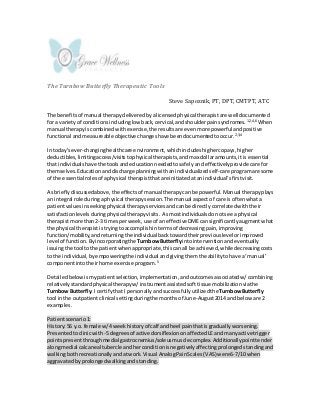
Turnbow Butterfly Document Author Steve Sapoznik PT, DPT, CMTPT, ATC
- 1. The Turnbow Butterfly Therapeutic Tools Steve Sapoznik, PT, DPT, CMTPT, ATC The benefitsof manual therapydeliveredbyalicensedphysical therapistare welldocumented for a varietyof conditionsincludinglow back,cervical,andshoulderpainsyndromes.1,2,4,6 When manual therapyiscombinedwithexercise,the resultsare evenmore powerful andpositive functional and measureable objective changeshave beendocumentedtooccur.2,3,4 In today'sever-changinghealthcare environment,whichincludeshighercopays,higher deductibles,limitingaccess/visitstophysical therapists,andmax dollaramounts,itisessential that individualshave the toolsandeducationneededtosafely andeffectivelyprovide care for themselves.Educationanddischarge planningwithanindividualizedself-care programare some of the essential rolesof aphysical therapistthatare initiatedatanindividual’sfirstvisit. As brieflydiscussedabove,the effectsof manual therapycanbe powerful.Manual therapyplays an integral role duringaphysical therapysession.The manual aspectof care is oftenwhata patientvaluesinseeking physical therapy servicesandcan be directly correlatedwith their satisfactionlevels duringphysicaltherapy visits. Asmostindividualsdonotsee a physical therapistmore than2-3 timesperweek,use of aneffectiveDMEcan significantlyaugmentwhat the physical therapististryingtoaccomplishintermsof decreasingpain,improving function/mobility,andreturningthe individual backtowardtheirpreviouslevel orimproved level of function. Byincorporatingthe TurnbowButterflyintointerventionandeventually issuingthe tool tothe patient whenappropriate,thiscanall be achieved, whiledecreasingcosts to the individual,byempoweringthe individual and givingthemthe abilityto have a‘manual’ componentintotheirhome exercise program.5 Detailedbelowismypatientselection,implementation,andoutcomesassociatedw/combining relativelystandardphysical therapyw/instrumentassistedsofttissue mobilizationviathe Turnbow Butterfly.I certifythat I personallyandsuccessfullyutilizedthe TurnbowButterfly tool inthe outpatientclinical settingduringthe monthsof June-August2014 andbelow are 2 examples. Patientscenario1: History:56 y.o.female w/4 weekhistoryof calf andheel painthatis graduallyworsening. Presentedtoclinicwith -5degreesof active dorsiflexion onaffectedLEand manyactive trigger pointspresentthroughmedial gastrocnemius/soleusmuscle complex.Additionallypointtender alongmedial calcaneal tubercleandherconditionisnegativelyaffecting prolongedstandingand walkingbothrecreationally andatwork.Visual AnalogPainScales(VAS) were6-7/10when aggravatedby prolongedwalkingandstanding.
- 2. Treatment:consistedof moistheattoposteriorknee andcalf,followedby10+ minutesof manual deeptissue mobilizationtomedial gastroc/soleus,whichthenwasproceededby prolongedgastroc/soleusstretchingandbalance andproprioceptiveexercisesof LE. Results:Visits1-2manual therapyinterventionwasdeliveredbytherapist'sownhandshowever patientthoughtitwas"too intense andpainful".Visits3-6beganusingthe Turnbow Butterflyto same area and patienttoleratedmuchbetterandforincreasedtime. Able tocompletemore exercisesfollowingmanual interventiondue toincreasedcomfortof the manual therapyviathe Turnbow Butterfly.Physiologicallydid see flushingof the skinandimprovedsofttissue mobility. Whenobjectivelymeasured,patient's active dorsiflexion improvedfrom-5degreesat evaluationandto +5 degreeswhichis 10 degree improvement.She noted beingable to ambulate relativelypainfree duringcommunityandrecreationalactivitiesandisoverall very pleasedwithresults. VASscoresimprovedto1-2/10. PatientScenario2: History:74 y.o.male w/30+ yearhistoryof chronic low back pain(LBP).Overthe years,painhas beensointense thathe has hadto be hospitalized.Hashadx-rayswhich showed"arthritis"per patientreport. He was referredto byhisprimarycare physician.Onthe date of evaluation,he noteda sharp increase orexacerbationof hisLBP while he wasseatedatwork.He isan online care salesmansoprolongedsittingandworkingata computerisrequiredforhis job. Patientwasobese howeverambulatoryw/outanyassistive devices.He deniedanymedical red flagsat evaluation,includingnohx of cancer and nobowel andbladderchanges. Examination:patient'sLBP wasveryhighand irritable ondate of evaluation. Hispaininlower lumbarregionandlateral glute regionbilaterallywasdirectlyexacerbatedbyanyextension posturesincludinglyingflat,transitioningfromsittostandingpostures,andbyupright ambulation.He demonstratedaslightlykyphotic posture andveryshortstep/stride length (almostshuffled) duringambulation.Hislumbarflexion measurementwas80 degreesand lumbarextensionwas5 degrees(bothwithpain) duringexam.He had2+/5 lowerabdominal strengthwhichwaspoor andverylimitedhamstring/hipmobility toPROMtestingbilaterally. Treatment:myinitial thoughtfortreatmentwastodecrease the patient's immediateLBP and irritabilitytoanymovement.Therefore,moistheat+softtissue mobilizationwasinitiatedat beginningof patient'ssessions.Since the patientwasalarge man,I decidedtouse instrument assistedsofttissue mobilizationviathe TurnbowButterflyto the patient's Bthoracolumbar paraspinalsandQL region,aswell asboth IT Bandsall in side lyingpositions.Instrumentassisted softtissue mobilizationwas administered for10-15 minutesandpositiveflushingof the skinwas observable andInoteda relaxationof the tone andspasmsinlumbarregion.Lumbar stabilization,hamstringstretching,andothergentle lumbopelvicstabilizationexerciseswere slowlyimplementedover9visits. Results:Onthe date of the patient's 9th visitwhichwas~4 weekslater,aformal re-evaluation
- 3. was performed.The patienthadseenasignificantincreaseintolerance toexercise andabilityto ambulate comfortablyperage expectednorms.He washavinglessLBP while seatedatwork and demonstratedabilitytocompletehisshiftsw/outtakinganyformof painmeds or mm relaxers.He notednearlyfull resolutionof hisBglute medpaininlateral hipregionbutstill had some mildtomod LBP inthe thoracolumbarregion.Hislumbarflexion improvedby5-10 degreesandlumbarextensionimprovedby5 degreesaswell withmuchlesspainduring repeatedmovementsof both.Physical therapy wasrecommendedtobe continuedforanother 2-4 weeksaswe were makingfunctionalandobjectiveprogresshoweveratthispointI moved to Indianaandanothertherapisttookoverhisplanof care. Takeaway:the use of instrumentedassistedsofttissue mobilizationinthoracolumbarandhip region+ the additionof targetedandspecificstabilizationexercises waspromotingareturn towardhispreviouslevelof functionwhichwascommunityambulationandabilitytositfor prolongedperiodsatworkwithout use of painmeds orsignificantrisesinLBP.Givenhis30+ yearhistoryof LBP, a majorgoal for thispatientwasto be able to complete averyspecificand flexion biasedhome exercise programasthese exercisesprovedtobe beneficial. Additionally,as softtissue mobilizationormanual therapywaseffective indecreasinghisLBP,he wouldhave benefitedfromthe abilitytoprovide some formof thisinterventionhimself.Thisisexactly where issuingthe TurnbowButterflywouldhave appropriate. The Turnbow Butterflycan be utilized,andthe time aphysical therapistusesitfor,billedforby 2 differentCPTcodes. The codesare: TherapeuticExercises(97110) and Manual Therapy (97140). A case can be made that othercommonCPT codescan be billed dependingonthe physical therapistsintentof treatment(i.e.TherapeuticActivityand/orNeuromuscular Reeducation). In the outpatientsetting,DMEcan be distributedin2ways:1) the therapistrecommendsatool or device andthe patientpurchaseswiththeirownmoneyorwithFSA/HSA accountsand2) insurancesmaycoverthe costs of DME, dependingonthe plan,if aphysicianscriptissubmitted and the DME isdeterminedmedicallynecessary.A physical therapistgenerallyisthe one to suggestuse of DME can justify medical necessitywithinanindividual’splanof care. This scenarioislargelythe same whetherdiscussingprivate insurance orworkmen’scompensation benefits. Personallyspeaking,there isnotasingle weekthatgoesbyinwhichI am not issuingsome form of DME to the patient,regardless of cost.Consumerswillpayforservicesanddevicesor equipmenttheyseethe value in. A well-designedandindividualizedhome exercise programcan have a tremendousimpactonan individual’sshortandlong-termhealthandthe Turnbow Butterfly wouldbe a valuable additiontoboththe physical therapyclinicand home for individual use. *“A proactive approachto preventionandmaintenance providesacompetitiveadvantage, the Turnbow Butterflyis the perfectself treatmenttool forathletestostayinthe game.” *“The use of the Turnbow Butterflycan increase rate of recoveryandreduce re admissions.”
- 4. 1. Bang MD, et al. Comparison of SupervisedPhysical Therapy Withand Without Manual Physical Therapy for Patients with ShoulderImpingementSyndrome. JOrthop Sports Phys Ther. 2000;30:126-137. 2. Bronfort G,Evans R, AndersonAV, et al. Spinal manipulation, medication,or home exercise withadvice for acute and sub acute neck pain: a randomizedtrial. Ann. Intern. Med. 2012;156(1 Pt 1):1–10. 3. WalkerMJ, BoylesRE, Young BA, et al. The effectivenessof manual physical therapy and exercise formechanical neck pain: a randomizedclinical trial. Spine.2008;33(22):2371– 2378. 4. Hoving JL, de Vet HCW,Koes BW,et al. Manual therapy, physical therapy, or continuedcare by the general practitioner for patientswith neck pain:long-termresults from a pragmatic randomizedclinical trial. Clin J Pain. 2006;22(4):370– 377. 5. Korthals-de Bos IBC, Hoving JL, van Tulder MW,et al. Cost effectivenessofphysiotherapy,manual therapy, and general practitioner care for neck pain: economicevaluation alongside a randomizedcontrolledtrial. BMJ. 2003;326(7395):911. 6. ClelandJA,Fritz JM, KuligK, etal. Comparison of the effectivenessofthree manual physical therapy techniquesin a subgroupof patientswith low back pain who satisfya clinical predictionrule:a randomizedclinical trial. Spine. 2009;34(25):2270-2729. Author: Steve Sapoznik, PT, DPT, CMTPT, ATC Facility Manager/Physical Therapist/Athletic Trainer Athletico Physical Therapy Bloomington, IN Clinic 3243 W. 3rd Street, Bloomington, IN 47404 P: 812-668-1880 | F: 812-668-1881 steven.sapoznik@athletico.com | ssapoznik@athletico.com )